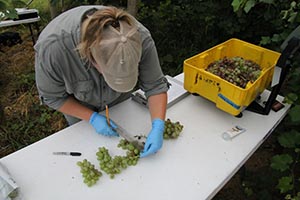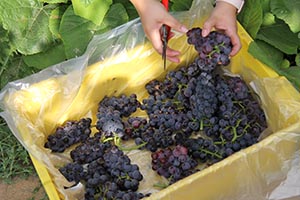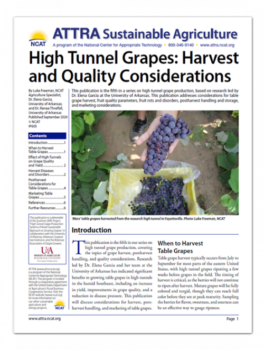High Tunnel Grapes: Harvest and Quality Considerations
By Luke Freeman, NCAT Agriculture Specialist; Dr. Elena Garcia, University of Arkansas; and Dr. Renee Threlfall, University of Arkansas
Abstract
This publication is the fifth in a series on high tunnel grape production, based on research led by Dr. Elena Garcia at the University of Arkansas. This publication addresses considerations for table grape harvest, fruit quality parameters, fruit rots and disorders, postharvest handling and storage, and marketing considerations.
‘Mars’ table grapes harvested from the research high tunnel in Fayetteville. Photo: Luke Freeman, NCAT

Introduction
This publication is the fifth in our series on high tunnel grape production, covering the topics of grape harvest, postharvest handling, and quality considerations. Research led by Dr. Elena Garcia and her team at the University of Arkansas has indicated significant benefits to growing table grapes in high tunnels in the humid Southeast, including an increase in yield, improvements in grape quality, and a reduction in disease pressure. This publication will discuss considerations for harvest, postharvest handling, and marketing of table grapes.

Graduate student Karlee Pruitt measures the cluster size and weight of ‘Faith’ table grapes from the high tunnel in Cabot, Arkansas. Photo: Luke Freeman, NCAT
When to Harvest Table Grapes
Table grape harvest typically occurs from July to September for most parts of the eastern United States, with high tunnel grapes ripening a few weeks before grapes in the field. The timing of harvest is critical, as the berries will not continue to ripen after harvest. Mature grapes will be fully colored and turgid, though they can reach full color before they are at peak maturity. Sampling the berries for flavor, sweetness, and sourness can be an effective way to gauge ripeness.
There are also analytical means of determining when table grapes are ready to harvest. As grapes ripen, the sugars increase and acids decrease, making these two factors good indicators of berry maturity. Sugar content is measured in soluble solids, which can be assessed with a hand-held refractometer. Depending on the cultivar, mature table grapes will range from 14% to 18% soluble solids (Crisosto and Mitchell, 2002). The acidity of the grapes can be measured by pH or by determining the titratable acidity. Sugar-to-acid ratio is another metric that can be used. Thomson Seedless, for example, is mature at a sugar-to-acid ratio of 18:1.
Although the flavor of table grapes will become more intense the longer they hang on the vine, leaving grapes on the vine for too long can pose problems. If grapes are allowed to remain on the vine beyond their optimum maturity, berry-splitting or shriveling may occur, in addition to potential loss from birds, raccoons, other pests, and fruit rots. Grape clusters should be harvested by gently supporting the cluster with one hand while cutting the stem with pruners. Table grapes should be set gently into clean harvest containers, so as not to damage the berries. Shallow plastic grape lugs, which are vented and can be stacked in the cooler, are commonly used for harvest.

Graduate student Jose Hernandez harvests table grapes from the research high tunnel in Fayetteville, Arkansas. Photo: Luke Freeman, NCAT
Effect of High Tunnels on Grape Quality and Yield
University of Arkansas research has shown a positive effect of high tunnel production on the postharvest quality of table grapes. In research conducted in 2017 on the cultivars Gratitude, Jupiter, and Mars, postharvest weight loss and decay were lower for grapes grown in the high tunnel compared to grapes grown in the field. The cultivars Jupiter and Mars also showed less postharvest shatter when grown in the high tunnel (Felts et al., 2018). These results were replicated for ‘Jupiter’ in 2018 (Beasley et al., 2019).
Average yields for table grapes in the high tunnel over the past three years (2016 to 2018) were significantly higher than historical yields for the same cultivars tested in the field at the UA Fruit Research Station in Clarksville. The three-year average yield increase was 41% for ‘Faith’, 52% for ‘Gratitude’, and 38% for ‘Jupiter’ grown in the high tunnel. The higher yield did result in lower fruit quality in 2017, when the cultivar Gratitude had extensive sour rot. In 2018, the UA research team implemented a cluster-thinning study to explore whether intentionally lowering vine yield in the tunnel would improve grape quality. This study was inconclusive, as yield reductions were seen in 2018 but not in 2019.
Harvest Diseases and Disorders
Shatter occurs when grape berries do not develop or fall off, leading to clusters that are “scraggly” in appearance and missing berries. One cause of shatter is grape flowers not being pollinated, which can be triggered by periods of cold, cloudy, rainy weather or unseasonably warm temperatures. Some cultivars are more prone to shatter than others, though severe pruning or excess fertilization can also exacerbate the problem. Shatter can also occur when grapes are left too long on the vine or when clusters are handled roughly during harvest, causing berries to fall off the cluster. Shatter can be a problem particularly when selling grapes to grocery stores or wholesale markets. Direct-to-consumer markets are much more forgiving of cosmetic disorders like this.

A cluster of ‘Faith’ table grapes that have been infected by sour rot. Photo: Luke Freeman, NCAT
Black Rot (Guignardia bidwellii) can lead to significant loss of yield, especially in the humid Southeast. An infected berry will first appear light brown and soon turn dark brown, with black fungal pycnidia developing on its surface. Berries will eventually shrivel, turning hard and black, at which point they are referred to as mummies. The fungus can be identified on leaves and shoots mid-season by brown circular or elliptical lesions.
Powdery Mildew (Uncinula necator) can cause grape berries to split and lead to a blotchy appearance on red and purple grapes, making them unmarketable and causing off-flavors. Berries are most susceptible to powdery mildew (PM) infection when their sugar content reaches 8% (Galetta and Himelrick, 1990). During the season, PM will appear as a white or greyish-white powdery covering on the upper and lower surfaces of leaves, with expanding leaves becoming distorted and stunted. In late summer, the PM fungus produces round, black bodies, called cleistothecia, on the surface of infected leaves, shoots, and berries.
Downy Mildew (Plasmopara viticola) can cause direct yield loss by rotting grape inflorescences, clusters, and shoots. It will cause yellow-green lesions on the upper surfaces of leaves, with white “downy” sporulation of the fungus forming on the lower leaf surface within the borders of the lesions. In humid weather, the white downy sporulation can even be seen on berries.
Botrytis Bunch Rot (Botrytis cinerea) can be especially severe in grape cultivars with tight, closely packed clusters. The berries of white grapes will become brown and shriveled after infection. Purple grapes will develop a reddish color with a fluffy, grey-brown fungal growth that can be seen under proper weather conditions.
Sour Rot (also known as sour bunch rot or summer bunch rot) is a late-season disease complex caused by fungi, yeasts, and bacteria that causes fruit to become soft and watery. It is favored by wet weather and wounds or injury to fruit. Cultivars with tight clusters and thin skins are more susceptible to this disease. Sour rot is often confused with Botrytis bunch rot because they both begin as a watery rot, but with sour rot, the typical
Botrytis fungal spores do not develop and the fruit has a vinegar odor with juice oozing out of the berries and dripping onto other fruit in the bunch.

Table grapes should be handled gently during harvest and picked into shallow
containers to avoid crushing. Photo: Luke Freeman, NCAT
Postharvest Considerations for Table Grapes
Handling and Storage
Grapes should be handled carefully and harvested into shallow containers to avoid damaging and crushing the berries. Grapes should be harvested dry and never washed after harvest. If grapes are wet from rain or dew, they should be allowed to dry before harvest to prevent postharvest rots caused by free moisture.
While grapes are in storage, moisture loss is the most common cause of postharvest deterioration (Crisosto and Mitchell, 2002). To reduce water loss, grapes should be cooled as quickly as possible after harvest and stored in slit bags or other containers that maintain a high humidity. Grapes should be cooled to 35°F as soon as possible after harvest, with forced-air cooling being the preferred method. After they are cooled, grapes should be stored at 31 to 32°F with 85 to 95% humidity. In these conditions, table grapes have a shelf life of four to seven weeks (Slama and Diffley, 2017).
Postharvest Diseases
Grey mold (Botrytis cinerea) is the most significant postharvest disease of table grapes. The fungus can develop at temperatures of 31°F and spread from one grape to another in a cluster (Crisosto and Mitchell, 2002). It is identified at first by the “slipskin” condition that develops on some berries and later by “nests” of decayed berries covered in a white fungal mycelium. Botrytis rot can be controlled by the introduction of sulfur dioxide (SO2) gas during forced-air cooling, though this method is impractical for small-scale growers and not allowed in organic production. The use of ozone gas shows promise as an alternative to sulfur dioxide for organic growers (Gabler et al., 2010). Other postharvest diseases that can affect grapes include black rot, ripe rot, Macrophoma rot, powdery mildew, blue mold, Alternaria, and Cladosporium rot (Slama and Diffley, 2017).
Shatter can also occur postharvest, caused by rough handling, packing clusters too deep, or improper storage temperatures. Controlling packing density, maintaining the correct storage environment, and using cluster bagging can all help prevent postharvest shatter (Crisosto et al., 1998).

Dr. Elena Garcia and graduate student Karlee Pruitt with ‘Gratitude’ table grapes harvested from the high tunnel. Photo: Luke Freeman, NCAT
Marketing Table Grapes
The vast majority of table grapes consumed in the United States are seedless grapes grown in California and South America, which have milder flavors than varieties that can be grown in the eastern United States. Because of this, there is a niche market for locally grown table grapes with more robust flavor. High tunnels allow for the production of high-quality table grapes from Labrusca-hybrid cultivars such as ‘Mars,’ ‘Jupiter,’ ‘Hope,’ and ‘Faith,’ which have very distinct flavor profiles and local appeal. High tunnel table grape production is a high-input, high-output production system that is well suited for small farms selling to local markets such as farmers markets, roadside stands, or gourmet-foods grocery stores. Local grapes can demand a premium price—as much as $6 per pound—when sold direct-to-consumer.
High Tunnel Grapes: Harvest and Quality Considerations
By Luke Freeman, NCAT Agriculture Specialist; Dr. Elena Garcia, University of Arkansas; and Dr. Renee Threlfall, University of Arkansas
IP605
Slot 631
This publication is produced by the National Center for Appropriate Technology through the ATTRA Sustainable Agriculture program, under a cooperative agreement with USDA Rural Development. This publication was also made possible in part by funding from the Southern SARE, through the project “High Tunnel Grape Production Systems: A Novel Sustainable Approach to Growing Grapes,” in collaboration with the University of Arkansas, Arkansas Cooperative Extension, and the Arkansas Association of Grape Growers. ATTRA.NCAT.ORG.
Related Resources
- High Tunnel Grapes: Establishment
- High Tunnel Grapes: Pruning, Trellising, and Training
- High Tunnel Grapes: Pest Management
- High Tunnel Grapes: Temperature and Soil Management
- Grapes: Organic Production
- High Tunnel Grapes: Cluster Thinning
- High Tunnel Grapes: Winter Pruning
- High Tunnel Grapes: Trellising & Training


